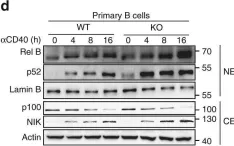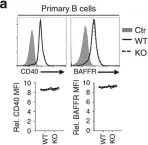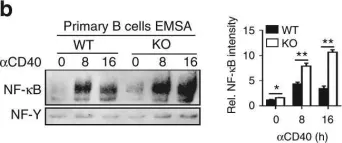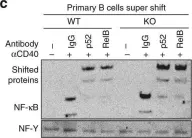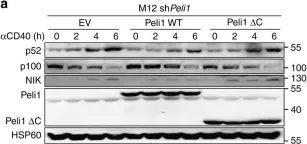Follicular B (FOB) and marginal zone B (MZB) cells are pivotal in humoral immune responses against pathogenic infections. MZB cells can exacerbate endotoxic shock via interleukin-6 secretion. Here we show that the transcriptional repressor capicua (CIC) and its binding partner, ataxin-1-like (ATXN1L), play important roles in FOB and MZB cell development. CIC deficiency reduces the size of both FOB and MZB cell populations, whereas ATXN1L deficiency specifically affects MZB cells. B cell receptor signaling is impaired only in Cic-deficient FOB cells, whereas Notch signaling is disrupted in both Cic-deficient and Atxn1l-deficient MZB cells. Mechanistically, ETV4 de-repression leads to inhibition of Notch1 and Notch2 transcription, thereby inhibiting MZB cell development in B cell-specific Cic-deficient (Cicf/f;Cd19-Cre) and Atxn1l-deficient (Atxn1lf/f;Cd19-Cre) mice. In Cicf/f;Cd19-Cre and Atxn1lf/f; Cd19-Cre mice, humoral immune responses and lipopolysaccharide-induced sepsis progression are attenuated but are restored upon Etv4-deletion. These findings highlight the importance of the CIC-ATXN1L complex in MZB cell development and may provide proof of principle for therapeutic targeting in sepsis.
© 2024. The Author(s).
Product Citations: 23
In Nature Communications on 4 December 2024 by Park, J. S., Kang, M., et al.
-
Mus musculus (House mouse)
-
Immunology and Microbiology
In ImmunoHorizons on 11 July 2022 by Eddie, A. M., Chen, K. W., et al.
The type 2 cytokines IL-4 and IL-13, which share use of an IL-4 receptor α-chain and its nuclear induction of the transcription factor STAT6, are crucial in elicitation and maintenance of allergic conditions including asthma. STAT6 binds poly(ADP-ribose) polymerase (PARP)14, an ADP-ribosyl monotransferase. Elimination of PARP14 by gene targeting led to attenuation of OVA-specific allergic lung inflammation. However, PARP14 has multiple functional domains apart from the portion that catalyzes ADP-ribosylation, and it is not clear whether inhibition of the catalytic function has any biological consequence. Using BALB/c mice sensitized to the allergen Alternaria alternata, we show that peroral administration of RBN012759, a highly selective inhibitor of ADP-ribosylation by PARP14 with negligible impact on other members of the PARP gene family, achieved biologically active plasma concentrations and altered several responses to the Ag. Specifically, the pharmaceutical compound decreased mucus after allergen challenge, blunted the induced increases in circulating IgE, and prevented suppression of IgG2a. We conclude that PARP14 catalytic activity can contribute to pathogenesis in allergic or atopic processes and propose that other biological endpoints dependent on ADP-ribosylation by PARP14 can be targeted using selective inhibition.Copyright © 2022 The Authors.
-
WB
-
Mus musculus (House mouse)
-
Cardiovascular biology
In eLife on 22 March 2021 by Ulbricht, C., Leben, R., et al.
Calcium is a universal second messenger present in all eukaryotic cells. The mobilization and storage of Ca2+ ions drives a number of signaling-related processes, stress-responses, or metabolic changes, all of which are relevant for the development of immune cells and their adaption to pathogens. Here, we introduce the Förster resonance energy transfer (FRET)-reporter mouse YellowCaB expressing the genetically encoded calcium indicator TN-XXL in B lymphocytes. Calcium-induced conformation change of TN-XXL results in FRET-donor quenching measurable by two-photon fluorescence lifetime imaging. For the first time, using our novel numerical analysis, we extract absolute cytoplasmic calcium concentrations in activated B cells during affinity maturation in vivo. We show that calcium in activated B cells is highly dynamic and that activation introduces a persistent calcium heterogeneity to the lineage. A characterization of absolute calcium concentrations present at any time within the cytosol is therefore of great value for the understanding of long-lived beneficial immune responses and detrimental autoimmunity.
© 2021, Ulbricht et al.
-
Mus musculus (House mouse)
-
Immunology and Microbiology
Single Cell Imaging of Nuclear Architecture Changes.
In Frontiers in Cell and Developmental Biology on 10 August 2019 by Morrish, R. B., Hermes, M., et al.
The dynamic architecture of chromatin, the macromolecular complex comprised primarily of DNA and histones, is vital for eukaryotic cell growth. Chemical and conformational changes to chromatin are important markers of functional and developmental processes in cells. However, chromatin architecture regulation has not yet been fully elucidated. Therefore, novel approaches to assessing chromatin changes at the single-cell level are required. Here we report the use of FTIR imaging and microfluidic cell-stretcher chips to assess changes to chromatin architecture and its effect on the mechanical properties of the nucleus in immune cells. FTIR imaging enables label-free chemical imaging with subcellular resolution. By optimizing the FTIR methodology and coupling it with cell segmentation analysis approach, we have identified key spectral changes corresponding to changes in DNA levels and chromatin conformation at the single cell level. By further manipulating live single cells using pressure-driven microfluidics, we found that chromatin decondensation - either during general transcriptional activation or during specific immune cell maturation - can ultimately lead to nuclear auxeticity which is a new biological phenomenon recently identified. Taken together our findings demonstrate the tight and, potentially bilateral, link between extra-cellular mechanotransduction and intra-cellular nuclear architecture.
-
Mus musculus (House mouse)
Peli1 negatively regulates noncanonical NF-κB signaling to restrain systemic lupus erythematosus.
In Nature Communications on 19 March 2018 by Liu, J., Huang, X., et al.
Systemic lupus erythematosus (SLE) is characterized by uncontrolled secretion of autoantibodies by plasma cells. Although the functional importance of plasma cells and autoantibodies in SLE has been well established, the underlying molecular mechanisms of controlling autoantibody production remain poorly understood. Here we show that Peli1 has a B cell-intrinsic function to protect against lupus-like autoimmunity in mice. Peli1 deficiency in B cells induces autoantibody production via noncanonical NF-κB signaling. Mechanically, Peli1 functions as an E3 ligase to associate with NF-κB inducing kinase (NIK) and mediates NIK Lys48 ubiquitination and degradation. Overexpression of Peli1 inhibits noncanonical NF-κB activation and alleviates lupus-like disease. In humans, PELI1 levels negatively correlate with disease severity in SLE patients. Our findings establish Peli1 as a negative regulator of the noncanonical NF-κB pathway in the context of restraining the pathogenesis of lupus-like disease.
-
WB post IP
-
IA
-
EMSA
-
In Vitro
-
WB
-
FC/FACS
-
Mus musculus (House mouse)
In Nat Commun on 19 March 2018 by Liu, J., Huang, X., et al.
Fig.4.D

-
WB
-
Mus musculus (House mouse)
Collected and cropped from Nat Commun by CiteAb, provided under a CC-BY license
Image 1 of 5
In Nat Commun on 19 March 2018 by Liu, J., Huang, X., et al.
Fig.4.A

-
FC/FACS
-
Mus musculus (House mouse)
Collected and cropped from Nat Commun by CiteAb, provided under a CC-BY license
Image 1 of 5
In Nat Commun on 19 March 2018 by Liu, J., Huang, X., et al.
Fig.4.B

-
WB
-
Mus musculus (House mouse)
Collected and cropped from Nat Commun by CiteAb, provided under a CC-BY license
Image 1 of 5
In Nat Commun on 19 March 2018 by Liu, J., Huang, X., et al.
Fig.4.C

-
WB
-
Mus musculus (House mouse)
Collected and cropped from Nat Commun by CiteAb, provided under a CC-BY license
Image 1 of 5
In Nat Commun on 19 March 2018 by Liu, J., Huang, X., et al.
Fig.7.A

-
WB
-
Mus musculus (House mouse)
Collected and cropped from Nat Commun by CiteAb, provided under a CC-BY license
Image 1 of 5
